[Note: This article first appeared in June 2015.]
“You will always be in our heart … because in there you’re still alive.” —Angelina Hubertus, 8, writing to the apple tree ‘Margaret’ in her diary
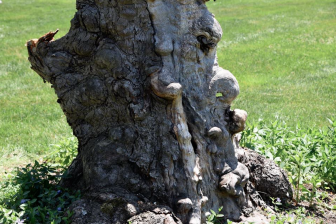
Margaret Hubertus in profile. Contributed
The Hubertus family cannot say just how or when it settled on ‘Margaret’ in naming the apple tree by the driveway of this lovingly landscaped 4-acre Oenoke Ridge Road property.
Yet at some point for Gregory and Linda Hubertus, and their 8-year-old daughter Angelina, Margaret’s eyes, nose and lips took shape in the tree’s knobby trunk, and there is something in the tree’s bearing and bark (the plant is estimated to be 300 years old) that animates, gives an impression of a living thing that is more than passive.

Angelina and Barley Hubertus playing near the apple tree this past winter. Contributed
Straightaway after purchasing this upper Oenoke property last summer and moving into its 1810-built house, the Hubertuses found themselves gathering near Margaret, turning toward her—Angelina and her friends pedaling their bikes around the tree last fall, family golden-doodle Barley playing on the snow piled up near the tree this winter, and Gregory just weeks ago voicing a plan to relocate some outdoor furniture in her ample shade.
“Everybody loves this apple tree,” Linda told NewCanaanite.com on a recent morning. “We mentioned it every day.”
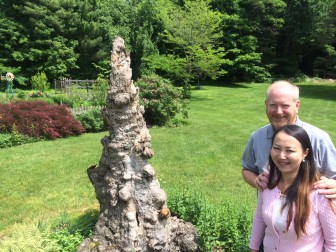
Gregory and Linda Hubertus stand by what remains of the venerable apple tree at 1462 Oenoke Ridge Road, weeks after the estimated 300-year-old tree died. Credit: Michael Dinan
So the Hubertuses felt the loss keenly when—on a sunny, wind-less Tuesday afternoon and amid a magnificent early-May bloom—Margaret suddenly toppled over, revealing an almost completely hollowed-out trunk.
“Spring had come and it [the tree] blossomed, showed us its magnificence and splendor, and that was it,” Gregory recalled. “It was like the tree was saying, ‘No way I’m going to allow you to put a table under here. I’m just going to show you one last shot of this, one last view, and then I’m out of here.’ It happened while we were all sitting here, admiring the blossoms that were falling down, and it just went. Bam.”
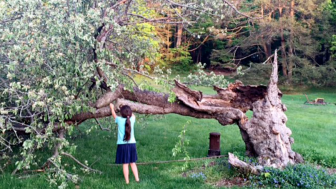
Angelina Hubertus on seeing that the apple tree had toppled. Contributed
Bam, and then tears. Angelina, a West School second-grader, hopped off the bus that day and froze when she caught sight of the fallen tree and trunk cracked open, crying as she ran to the tree and hugged its branches (and, at first, blaming her dad for threatening to place a bench beneath it).
Reflecting now on the apple tree itself, and the antique home that it had overseen for more than two centuries, the Hubertuses view Margaret’s dramatic farewell as rather more than a bookend to the life cycle of a perennial plant: In studying the history of the house, and gleaning what they can of past owners, the family has reconciled with Margaret’s loss and forged an even deeper connection to a property for which they felt an immediate, visceral affinity.
________________________________________________
Note: For the first two weeks of August, we are re-running one popular feature story from the NewCanaanite.com archives that you may have missed.
________________________________________________
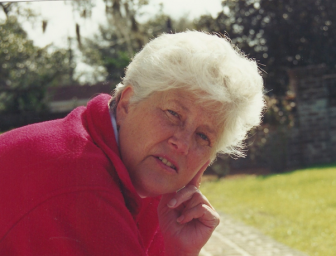
Elizabeth Chilton. Contributed
As Gregory put it: “It was like the tree said, ‘I’m going to show you how beautiful and spectacular I am, but I am going with her.’ ”
‘Her’ being the late Elizabeth Chilton, a master gardener who owned and cultivated the property prior to her passing in 2013 following a long illness. A prominent local woman who had been deeply involved in both the New Canaan Historical Society and New Canaan Nature Center, Chilton was the latest in a line of residents of the house that included, historians say, one of the area’s most widely known ministers as well as the man who gave the town its first automotive fire engine.
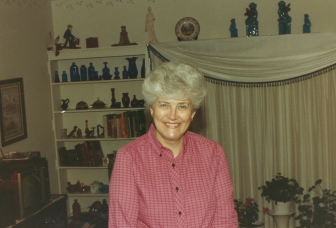
Elizabeth Chilton. Contributed
That background likely became known to Chilton when she acquired the house and grounds in 2006 (and promptly set about landscaping them expertly). “My mother was a true historian of anything and everything,” said her daughter, Cindy Leonard of Wilton, adding that her mom’s (‘Liz,’ as she was known) favorite movie was “1776!”
Already an accomplished preservationist when she moved to New Canaan around 2000 to be nearer her kids and grandkids, Chilton’s true and abiding love was horticulture, and the apple tree “absolutely” was her very favorite on the Oenoke property, Leonard said.
“She loved to garden,” Leonard said. “That was her passion and she did it every single day of her life. If she wasn’t doing it outside, she was doing it in the greenhouse.”

Elizabeth Chilton. Contributed
And sharing that love with the wider community.
Though she had met Chilton personally only a couple of times, Laura Heckman, executive director of the New Canaan Nature Center, said Liz was known for going far above and beyond in planning an annual Horticultural Symposium at the Nature Center. A major donor for the event, Chilton was involved in the granular details of the symposium.
“We are hugely grateful, because she was very steadfast and did it year after year and was very loyal,” Heckman said.

Angelina and Barley Hubertus.
One corner of the Greenhouse at the Nature Center was established with funding from the Chilton Foundation.
When Chilton passed, the family following a Mass at St. Aloysius Church hosted a memorial for her at the Oenoke Ridge Road house.
“That was what she wanted, she told us she wanted to do that, to have a party when all of her plants were in blossom, so that she could be there with her plants,” Leonard recalled. “A lot of her friends were away for the winter so we waited for June and there were more than 125 people at it, on a beautiful day.”

Angelina Hubertus (R) with a friend, riding bikes near the apple tree at the end of the driveway. Contributed
Leonard added that her mom knew how old the apple tree was (“She talked about her trees all the time”) and if she was right (that it was 300), that would be a very unusual tree.
Asked generally about how old apple trees can get, New Canaan Tree Warden Bruce Pauley said 300 is “possible, but extremely unlikely.”
Pauley said counting growth rings on a tree that old is impossible because it would be hollowed out (true in this case).
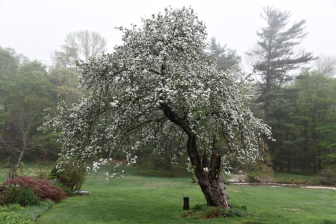
The apple tree in bloom in May 2015. Contributed
“Usually, apple trees succumb to disease, poor growing conditions, bad pruning practices, breakage from their own weight, or one or more of myriad possibilities by the time they reach somewhere near 100 years of age—usually well before,” said the tree warden, himself a fourth-generation New Canaanite. “There have been instances where apple trees travel. The tree gets old, rotted, and heavy and uproots. The tree does not immediately die, but some part of the living crown takes root and becomes a new tree as the old section rots into memory. The new tree is maybe 10 to 15 feet from the parent. This process could continue indefinitely and could arguably be said to be the original tree.”

Looking toward ‘Margaret’ at the end of the Hubertus family’s driveway, last fall. Contributed
If the tree was as old as estimated by those who knew it best, it saw quite a bit in that long lifetime, including plenty of activity at the historic home just 30 feet from where it stood.
Built around 1809-1810, the 2.5-story, clapboarded ‘Elias Lockwood House’ at an address once known as ’62 Pinney Road’ is “most significant for its notable central chimney, especially at its southern fireplace with its high, wide opening and beehive oven,” according to notes on file with a title search at the New Canaan Historical Society.
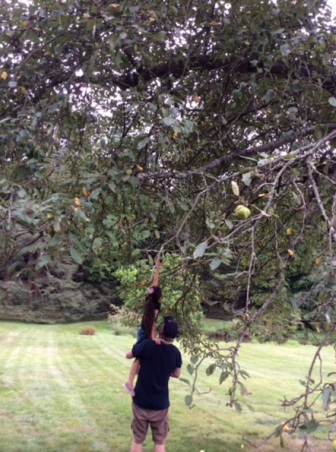
The apple tree named ‘Margaret’ by the Hubertus family of Oenoke Ridge Road. Contributed
Land records also on file at the Historical Society show that a house stood as early as about 1750 on a far larger property (30 acres) that included what is now the Hubertuses’ 4-acre parcel.
The larger property had been conveyed to Jacob Lockwood of Norwalk in 1783, the title search shows—Jacob being the son of a lieutenant colonel in the 9th Connecticut Regiment of the Continental Army during the American Revolutionary War.
Though it isn’t clear what happened after Jacob acquired the 30-acre parcel, it is thought that a son (Isaac) took over the house and that eventually it came to a neighbor, Elias Lockwood, son of a Norwalk native who had joined the Congregational Church of New Canaan in 1781, according to a title search by George Nelson that’s on file at the Historical Society.
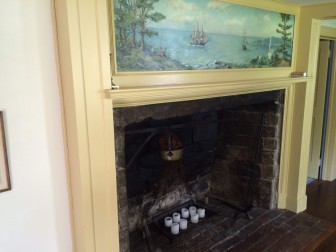
The fireplace inside the Elias Lockwood home on Oenoke Ridge. Credit: Michael Dinan
“Based on the fireplace, I would like to date the house from an earlier period (ca 1750),” Nelson writes. “Based on available records, I’ll have to say it is the Elias Lockwood homestead dating from about 1810.”
One of the owners and residents of that homestead from more than one century ago, is Alfred H. Mulliken—a man who, the historian Mary Louise King notes in her “Portrait of New Canaan”—gifted to New Canaan the town’s first auto fire engine in the fall of 1912, “a combination hose and chemical truck” that cost $6,000. (Mulliken, King notes, “probably was the largest single landowner in the history of the town, owning approximately 1,000 acres that he bought over a period of years.”)
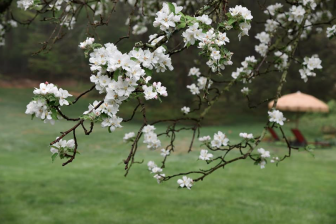
A branch of the apple tree on Oenoke Ridge Road. Contributed
Another owner of the home was the Rev. Isaac R. Brown, a New Canaan native who served as resident chaplain at the Soldier’s Home in Noroton prior to his passing in 1909, according to his obituary.
“Perhaps there is no other minister more widely known here and in the neighboring towns, and more deeply respected. Mr. Brown was the pride and close friend of his people at East Woods; the loyal, earnest, beloved comrade of the old soldiers at the Home,” the obituary says. “To his esteemed wife, Mr. Brown remained a devoted lover to the end of his days, and was a most wise and loving father. The influence of his life was far-reaching and all who knew him feel that he has given his best and his all in the service of God and man.”
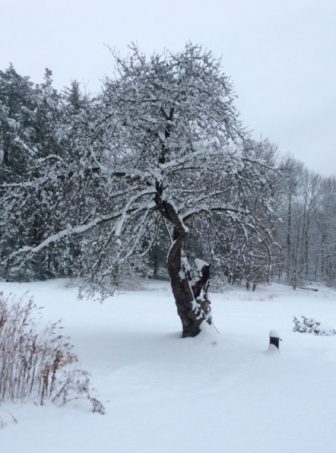
Margaret’s final winter. Contributed
A New Canaan Property Street Card on file at the Historical Society shows that the historic home and property sold in 1941 for $20,000.
New Canaan Historical Society Executive Director Janet Lindstrom said Chilton had been a deeply devoted preservationist and was a strong supporter of and “dream” volunteer with the nonprofit organization, for a period helping to oversee its 1764-built Hanford-Silliman House. Leonard confirmed that her mother put a lot of work into the house itself, as well as the grounds.
Up on Oenoke Ridge, the Historical Society notes, the property that would become Chilton’s was “dominated by a broad lawn accented by a small pond to the south but also including specimen trees such as sugar maple, white ash, white pine, white oak, pin oak and redcedar.”
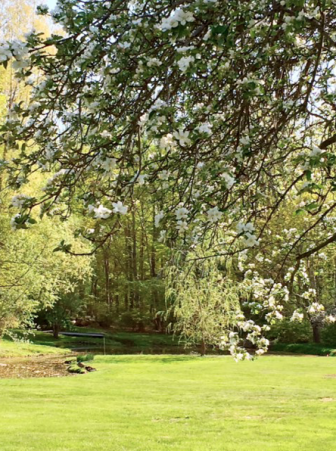
Looking past the apple tree, toward a pond on the property. Contributed
Many of those trees remain, and Chilton brought in dozens of irises and peonies (she tripled the gardens, her daughter said), also seeing to it that multiple flowering trees—cherry, dogwood, lilac and even a wisteria tree—also lived on the property, bringing new colors and vistas almost daily.
“Every week is dramatically different,” Gregory said.
Leonard said it had been somewhat intimidating growing up with a woman who was such an avid and gifted gardener, “and as soon as she left, I’ve been gardening like crazy.”
“I think I’m channeling her and she’s making me a much better gardener than I was,” Leonard said.

Angelina and Barley Hubertus. Contributed
Meanwhile, the stump of Chilton’s— and Hubertus family’s—favorite tree, still stands at the end of the driveway (the major features of Margaret’s “face” remain visible). The stump is surrounded by fern, iris and myrtle, and—told of how the tree fell and how it affected the family that now owns the property—Leonard said: “It was probably my mother saying, ‘You know what? I’m here and I’m going to help you with all these plants.’ She was very spiritual, so I wouldn’t doubt there was something to it.”
The Hubertus family also had named ‘Anna’ what they’re calling a “twin” to the apple tree Margaret—a similarly old tree that stands on the opposite side of the property, near a guest house and barn that Gregory and Linda are planning to convert to a piano studio for young Angelina, a gifted player who has performed solo at Carnegie Hall (note: Chilton also was a pianist).
Gregory said the family is planning to leave Margaret’s stump where it is.
“It’s almost like a memorial to the tree,” he said. “And Angelina is hoping that something will grow out of it.”